How Should Green Messages Be Framed: Single or Double?
Abstract
:1. Introduction
2. Theoretical Background
2.1. Green Advertising Appeals
2.2. Green Attributes of the Product
2.3. Product Attributes
2.4. Order Effect of Message Presentation
3. Hypotheses Development
3.1. Single-Message versus a Double-Message Advertisement
3.2. Role of Green Attributes
3.3. Impact of Message Order in a Double-Message Advertisement
4. Study 1
4.1. Experiment Design and Stimuli Advertisement
4.2. Dependent Variables
- (1)
- Denee shampoo is good.
- (2)
- Denee shampoo is pleasing.
- (3)
- Denee shampoo is attractive.
- (4)
- Denee shampoo is of good quality.
4.3. Subjects and Procedure
4.4. Results
4.4.1. Manipulation Check
4.4.2. Hypotheses Testing
5. Study 2
Results
6. Conclusions and Implications
6.1. Conclusions
6.2. Theoretical Implications
6.3. Managerial Implications
6.4. Limitations and Future Research
Author Contributions
Funding
Conflicts of Interest
Ethical Approval
Appendix A
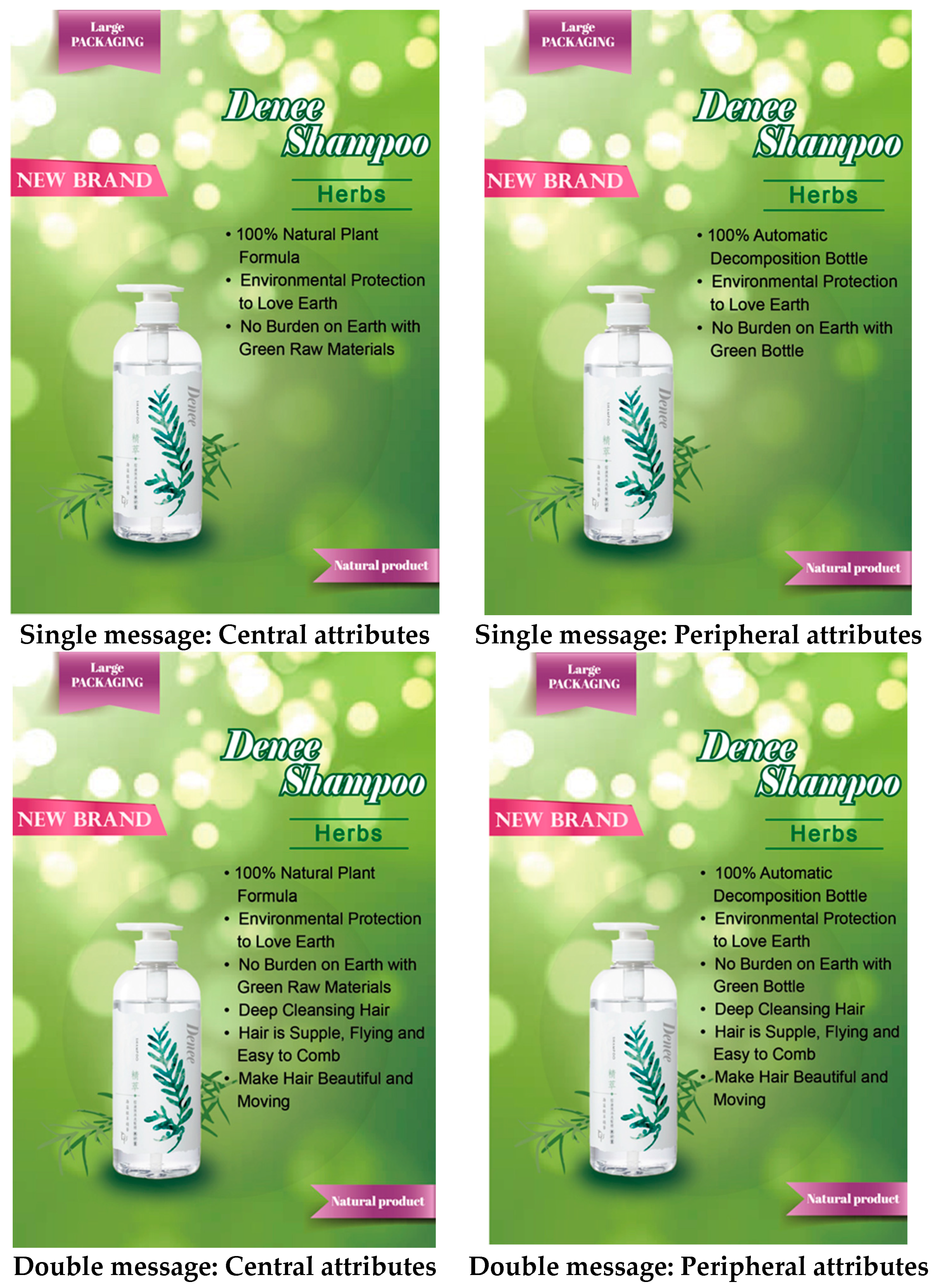
Appendix B
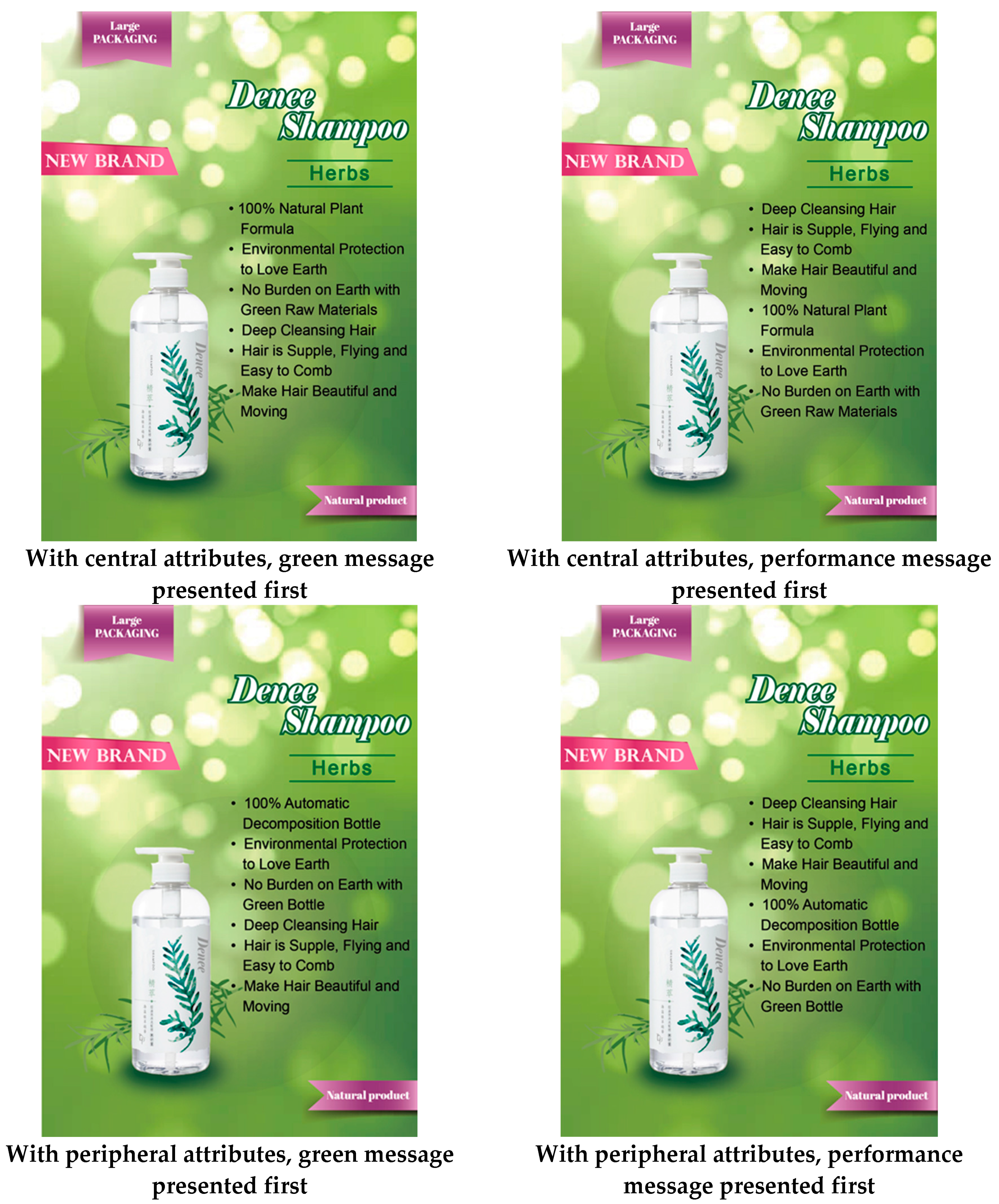
References
- Orsato, R.J. Competitive Environmental Strategies: When Does it Pay to be Green? Calif. Manag. Rev. 2006, 48, 127–143. [Google Scholar] [CrossRef] [Green Version]
- Woolverton, A.; Dimitri, C. Green Marketing: Are Environmental and Social Objectives Compatible with Profit Maximization? Renew. Agric. Food Syst. 2010, 25, 90–98. [Google Scholar] [CrossRef] [Green Version]
- Gosselt, J.; Rompay, T.; Haske, L. Won’t Get Fooled Again: The Effects of Internal and External CSR ECO-Labeling. J. Bus. Ethics 2019, 155, 1–12. [Google Scholar] [CrossRef] [Green Version]
- Iyer, E.; Banerjee, B. Anatomy of Green Advertising. Adv. Consum. Res. 1993, 20, 494–501. [Google Scholar]
- Durif, F.; Boivin, C.; Julien, C. In Search of a Green Product Definition. Innov. Mark. 2010, 6, 25–33. [Google Scholar]
- Janssen, M.A.; Jager, W. Stimulating Diffusion of Green Products. J. Evol. Econ. 2002, 12, 283–306. [Google Scholar] [CrossRef]
- Luchs, M.G.; Naylor, R.W.; Irwin, J.R.; Raghunathan, R. The Sustainability Liability: Potential Negative Effects of Ethicality on Product Preference. J. Mark. 2010, 74, 18–31. [Google Scholar] [CrossRef] [Green Version]
- Mackoy, R.D.; Calantone, R.J.; Droge, C.L. Environmental Marketing: Bridging the Divide Between the Consumption Culture and Environmentalism. In Environmental Marketing: Strategies, Practice, Theory, and Research; Haworth Press: Philadelphia, PA, USA, 1995; pp. 37–54. [Google Scholar]
- McDonald, S.; Oates Caroline, J.; Alevizou Panayiota, J. No Through Road: A Critical Examination of Researcher Assumptions and Approaches to Researching Sustainability. In Review of Marketing Research: Marketing in and for a Sustainable Society; Malhotra, N.K., Ed.; Emerald Group Publishing Limited: Bingley, UK, 2016; Volume 13, pp. 139–168. [Google Scholar]
- Skard, S.; Jørgensen, S.; Pedersen, L.J.T. When is Sustainability a Liability, and When is it an Asset? Quality Inferences for Core and Peripheral Attributes. J. Bus. Ethics 2020, 2020. [Google Scholar] [CrossRef] [Green Version]
- Chang, C. Feeling Ambivalent About Going Green. J. Advert. 2011, 40, 19–32. [Google Scholar] [CrossRef]
- Gershoff, A.D.; Frels, J.K. What Makes it Green? The Role of Centrality of Green Attributes in Evaluations of the Greenness of Products. J. Mark. 2015, 79, 97–110. [Google Scholar] [CrossRef]
- Kareklas, I.; Carlson, J.R.; Muehling, D.D. The Role of Regulatory Focus and Self-View in “Green” Advertising Message Framing. J. Advert. 2012, 41, 25–39. [Google Scholar] [CrossRef]
- Lu, L.-C.; Chang, H.-H.; Chang, A. Consumer Personality and Green Buying Intention: The Mediate Role of Consumer Ethical Beliefs. J. Bus. Ethics 2015, 127, 205–219. [Google Scholar] [CrossRef]
- Newman, G.E.; Gorlin, M.; Dhar, R. When Going Green Backfires: How Firm Intentions Shape the Evaluation of Socially Beneficial Product Enhancements. J. Consum. Res. 2014, 41, 823–839. [Google Scholar] [CrossRef] [Green Version]
- White, K.; Simpson, B. When Do (and Don’t) Normative Appeals Influence Sustainable Consumer Behaviors? J. Mark. 2013, 77, 78–95. [Google Scholar] [CrossRef] [Green Version]
- Berrone, P.; Fosfuri, A.; Gelabert, L.; Gomez-Mejia, L.R. Necessity as Mother of ‘Green’ Inventions: Institutional Pressures and Environmental Innovations. Strateg. Manag. J. 2013, 34, 891–909. [Google Scholar] [CrossRef]
- Chen, Y.-S.; Chang, C.-H. The Determinants of Green Product Development Performance: Green Dynamic Capabilities, Green Transformational Leadership, and Green Creativity. J. Bus. Ethics 2013, 116, 107–119. [Google Scholar] [CrossRef]
- Olson, E.L. Perspective: The Green Innovation Value Chain: A Tool for Evaluating the Diffusion Prospects of Green Products. J. Prod. Innov. Manag. 2013, 30, 782–793. [Google Scholar] [CrossRef]
- Green, T.; Peloza, J. Finding the Right Shade of Green: The Effect of Advertising Appeal Type on Environmentally Friendly Consumption. J. Advert. 2014, 43, 128–141. [Google Scholar] [CrossRef]
- Grimmer, M.; Woolley, M. Green Marketing Messages and Consumers’ Purchase Intentions: Promoting Personal versus Environmental Benefits. J. Mark. Commun. 2014, 20, 231–250. [Google Scholar] [CrossRef]
- Matthes, J.; Wonneberger, A. The Skeptical Green Consumer Revisited: Testing the Relationship Between Green Consumerism and Skepticism Toward Advertising. J. Advert. 2014, 43, 115–127. [Google Scholar] [CrossRef]
- Matthes, J.; Wonneberger, A.; Schmuck, D. Consumers’ Green Involvement and The Persuasive Effects of Emotional versus Functional Ads. J. Bus. Res. 2014, 67, 1885–1893. [Google Scholar] [CrossRef]
- Segev, S.; Fernandes, J.; Hong, C. Is Your Product Really Green? A Content Analysis to Reassess Green Advertising. J. Advert. 2016, 45, 85–93. [Google Scholar] [CrossRef]
- D’souza, C.; Taghian, M. Green Advertising Effects on Attitude and Choice of Advertising Themes. Asia Pac. J. Mark. Logist. 2005, 17, 51–66. [Google Scholar] [CrossRef] [Green Version]
- Leonidou, C.N.; Leonidou, L.C. Research into Environmental Marketing/Management: A Bibliographic Analysis. Eur. J. Mark. 2011, 45, 68–103. [Google Scholar] [CrossRef] [Green Version]
- Maignan, I.; Ferrell, O.C. Corporate Social Responsibility and Marketing: An Integrative Framework. J. Acad. Mark. Sci. 2004, 32, 3–19. [Google Scholar] [CrossRef]
- Mo, Z.; Liu, M.T.; Liu, Y. Effects of Functional Green Advertising on Self and Others. Psychol. Mark. 2018, 35, 368–382. [Google Scholar] [CrossRef]
- Song, S.Y.; Kim, Y.-K. Doing Good Better: Impure Altruism in Green Apparel Advertising. Sustainability 2019, 11, 5762. [Google Scholar] [CrossRef] [Green Version]
- Song, Y.; Luximon, Y. Design for Sustainability: The Effect of Lettering Case on Environmental Concern from a Green Advertising Perspective. Sustainability 2019, 11, 1333. [Google Scholar] [CrossRef] [Green Version]
- Zinkhan, G.M.; Carlson, L. Green Advertising and the Reluctant Consumer. J. Advert. 1995, 24, 1–6. [Google Scholar] [CrossRef]
- Banerjee, S.; Gulas, C.S.; Iyer, E. Shades of Green: A Multidimensional Analysis of Environmental Advertising. J. Advert. 1995, 24, 21–31. [Google Scholar] [CrossRef]
- Carlson, L.; Grove, S.J.; Kangun, N. A Content Analysis of Environmental Advertising Claims: A Matrix Method Approach. J. Advert. 1993, 22, 27–39. [Google Scholar] [CrossRef]
- Schmuck, D.; Matthes, J.; Naderer, B. Misleading Consumers With Green Advertising? An Affect–Reason–Involvement Account of Greenwashing Effects in Environmental Advertising. J. Advert. 2018, 47, 127–145. [Google Scholar] [CrossRef] [Green Version]
- Zhang, L.; Li, D.; Cao, C.; Huang, S. The Influence of Greenwashing Perception on Green Purchasing Intentions: The Mediating Role of Green Word-of-Mouth and Moderating Role of Green Concern. J. Clean. Prod. 2018, 187, 740–750. [Google Scholar] [CrossRef]
- Nguyen, T.T.H.; Yang, Z.; Nguyen, N.; Johnson, L.W.; Cao, T.K. Greenwash and Green Purchase Intention: The Mediating Role of Green Skepticism. Sustainability 2019, 11, 2653. [Google Scholar] [CrossRef] [Green Version]
- Fowler, A.R., III; Close, A.G. It Ain’t Easy Being Green: Macro, Meso, and Micro Green Advertising Agendas. J. Advert. 2012, 41, 119–132. [Google Scholar] [CrossRef]
- Luchs, M.G.; Kumar, M. “Yes, But This Other One Looks Better/Works Better”: How do Consumers Respond to Trade-Offs Between Sustainability and Other Valued Attributes? J. Bus. Ethics 2017, 140, 567–584. [Google Scholar] [CrossRef]
- Atkinson, L.; Rosenthal, S. Signaling the Green Sell: The Influence of Eco-Label Source, Argument Specificity, and Product Involvement on Consumer Trust. J. Advert. 2014, 43, 33–45. [Google Scholar] [CrossRef]
- Gutierrez, A.M.J.; Chiu, A.S.F.; Seva, R. A Proposed Framework on the Affective Design of Eco-Product Labels. Sustainability 2020, 12, 3234. [Google Scholar] [CrossRef] [Green Version]
- Anastasiou, C.N.; Keramitsoglou, K.M.; Kalogeras, N.; Tsagkaraki, M.I.; Kalatzi, I.; Tsagarakis, K.P. Can the “Euro-Leaf” Logo Affect Consumers’ Willingness-to-Buy and Willingness-to-Pay for Organic Food and Attract Consumers’ Preferences? An Empirical Study in Greece. Sustainability 2017, 9, 1450. [Google Scholar] [CrossRef] [Green Version]
- Pancer, E.; McShane, L.; Noseworthy, T.J. Isolated Environmental Cues and Product Efficacy Penalties: The Color Green and Eco-Labels. J. Bus. Ethics 2017, 143, 159–177. [Google Scholar] [CrossRef]
- Phau, I.; Ong, D. An Investigation of the Effects of Environmental Claims in Promotional Messages for Clothing Brands. Mark. Intell. Plan. 2007, 25, 772–788. [Google Scholar] [CrossRef]
- Ganz, B.; Grimes, A. How Claim Specificity can Improve Claim Credibility in Green Advertising: Measures that can Boost Outcomes from Environmental Product Claims. J. Advert. Res. 2018, 58, 476–486. [Google Scholar] [CrossRef] [Green Version]
- Montoro Rios, F.J.; Luque Martinez, T.; Fuentes Moreno, F.; Cañadas Soriano, P. Improving Attitudes Toward Brands With Environmental Associations: An Experimental Approach. J. Consum. Mark. 2006, 23, 26–33. [Google Scholar] [CrossRef] [Green Version]
- Tucker, E.M.; Rifon, N.J.; Lee, E.M.; Reece, B.B. Consumer Receptivity to Green Ads: A Test of Green Claim Types and the Role of Individual Consumer Characteristics for Green Ad Response. J. Advert. 2012, 41, 9–23. [Google Scholar] [CrossRef]
- Schuhwerk, M.E.; Lefkoff-Hagius, R. Green or Non-Green? Does Type of Appeal Matter When Advertising a Green Product? J. Advert. 1995, 24, 45–54. [Google Scholar] [CrossRef]
- Kronrod, A.; Grinstein, A.; Wathieu, L. Go Green! Should Environmental Messages be so Assertive? J. Mark. 2012, 76, 95–102. [Google Scholar] [CrossRef]
- Hartmann, P.; Apaolaza, V.; D’Souza, C.; Barrutia, J.M.; Echebarria, C. Environmental Threat Appeals in Green Advertising: The Role of Fear Arousal and Coping Efficacy. Int. J. Advert. 2014, 33, 741–765. [Google Scholar] [CrossRef]
- Peloza, J.; White, K.; Shang, J. Good and Guilt-Free: The Role of Self-Accountability in Influencing Preferences for Products with Ethical Attributes. J. Mark. 2013, 77, 104–119. [Google Scholar] [CrossRef] [Green Version]
- Bodur, H.; Duval, K.; Grohmann, B. Will You Purchase Environmentally Friendly Products? Using Prediction Requests to Increase Choice of Sustainable Products. J. Bus. Ethics 2015, 129, 59–75. [Google Scholar] [CrossRef]
- Lin, Y.-C.; Chang, C.-c.A. Double Standard: The Role of Environmental Consciousness in Green Product Usage. J. Mark. 2012, 76, 125–134. [Google Scholar] [CrossRef]
- Wood, S.; Robinson, S.; Poor, M. The Efficacy of Green Package Cues for Mainstream versus Niche Brands: How Mainstream Green Brands can Suffer at The Shelf. J. Advert. Res. 2018, 58, 165–176. [Google Scholar] [CrossRef]
- Olson, E.L. It’s not Easy Being Green: The Effects of Attribute Tradeoffs on Green Product Preference and Choice. J. Acad. Mark. Sci. 2013, 41, 171–184. [Google Scholar] [CrossRef] [Green Version]
- Arceneaux, K. Cognitive Biases and the Strength of Political Arguments. Am. J. Political Sci. 2012, 56, 271–285. [Google Scholar] [CrossRef]
- Liu, Y. Word of Mouth for Movies: Its Dynamics and Impact on Box Office Revenue. J. Mark. 2006, 70, 74–89. [Google Scholar] [CrossRef]
- Mizerski, R.W. An Attribution Explanation of the Disproportionate Influence of Unfavorable Information. J. Consum. Res. 1982, 9, 301–310. [Google Scholar] [CrossRef]
- Song, S.Y.; Kim, Y.-K. A Human-Centered Approach to Green Apparel Advertising: Decision Tree Predictive Modeling of Consumer Choice. Sustainability 2018, 10, 3688. [Google Scholar] [CrossRef] [Green Version]
- Sloman, S.A.; Love, B.C.; Ahn, W.K. Feature Centrality and Conceptual Coherence. Cogn. Sci. 1998, 22, 189–228. [Google Scholar] [CrossRef]
- Hampton, J.A.; Passanisi, A.; Jönsson, M.L. The Modifier Effect and Property Mutability. J. Mem. Lang. 2011, 64, 233–248. [Google Scholar] [CrossRef]
- Hogarth, R.M.; Einhorn, H.J. Order Effects in Belief Updating: The Belief-Adjustment Model. Cogn. Psychol. 1992, 24, 1–55. [Google Scholar] [CrossRef]
- Tubbs, R.M.; Gaeth, G.J.; Levin, I.P.; Van Osdol, L.A. Order Effects in Belief Updating with Consistent and Inconsistent Evidence. J. Behav. Decis. Mak. 1993, 6, 257–269. [Google Scholar] [CrossRef]
- Trotman, K.T.; Wright, A. Order Effects and Recency: Where do We Go from Here? Account. Financ. 2000, 40, 169–182. [Google Scholar] [CrossRef]
- Asch, S.E. Forming Impressions of Personality. J. Abnorm. Soc. Psychol. 1946, 41, 258–290. [Google Scholar] [CrossRef] [PubMed]
- Voss, K.E.; Spangenberg, E.R.; Grohmann, B. Measuring the Hedonic and Utilitarian Dimensions of Consumer Attitude. J. Mark. Res. 2003, 40, 310–320. [Google Scholar] [CrossRef]
- Luchs, M.G.; Brower, J.; Chitturi, R. Product Choice and the Importance of Aesthetic Design Given the Emotion-Laden Trade-Off between Sustainability and Functional Performance. J. Prod. Innov. Manag. 2012, 29, 903–916. [Google Scholar] [CrossRef]
- Zou, L.W.; Chan, R.Y.K. Why and When do Consumers Perform Green Behaviors? An Examination of Regulatory Focus and Ethical Ideology. J. Bus. Res. 2019, 94, 113–127. [Google Scholar] [CrossRef]
- Brough, A.R.; Wilkie, J.E.B.; Ma, J.; Isaac, M.S.; Gal, D. Is Eco-Friendly Unmanly? The Green-Feminine Stereotype and its Effect on Sustainable Consumption. J. Consum. Res. 2016, 43, 567–582. [Google Scholar] [CrossRef] [Green Version]
- Muralidharan, S.; Sheehan, K. The Role of Guilt in Influencing Sustainable Pro-Environmental Behaviors Among Shoppers: Differences in Response by Gender to Messaging About England’s Plastic-Bag Levy. J. Advert. Res. 2018, 58, 349–362. [Google Scholar] [CrossRef]
- Taufique, K.M.R.; Polonsky, M.J.; Vocino, A.; Siwar, C. Measuring Consumer Understanding and Perception of Eco-Labelling: Item Selection and Scale Validation. Int. J. Consum. Stud. 2019, 43, 298–314. [Google Scholar] [CrossRef]
- Sharma, N.K.; Kushwaha, G.S. Eco-Labels: A Tool for Green Marketing or Just a Blind Mirror for Consumers. Electron. Green J. 2019, 1, 42. [Google Scholar] [CrossRef]
- Taljaard, H.; Sonnenberg, N.C.; Jacobs, B.M. Factors Motivating Male Consumers’ Eco-Friendly Apparel Acquisition in the South African Emerging Market. Int. J. Consum. Stud. 2018, 42, 461–468. [Google Scholar] [CrossRef]
- Sundar, A.; Kellaris, J. How Logo Colors Influence Shoppers’ Judgments of Retailer Ethicality: The Mediating Role of Perceived Eco-Friendliness. J. Bus. Ethics 2017, 146, 685–701. [Google Scholar] [CrossRef]

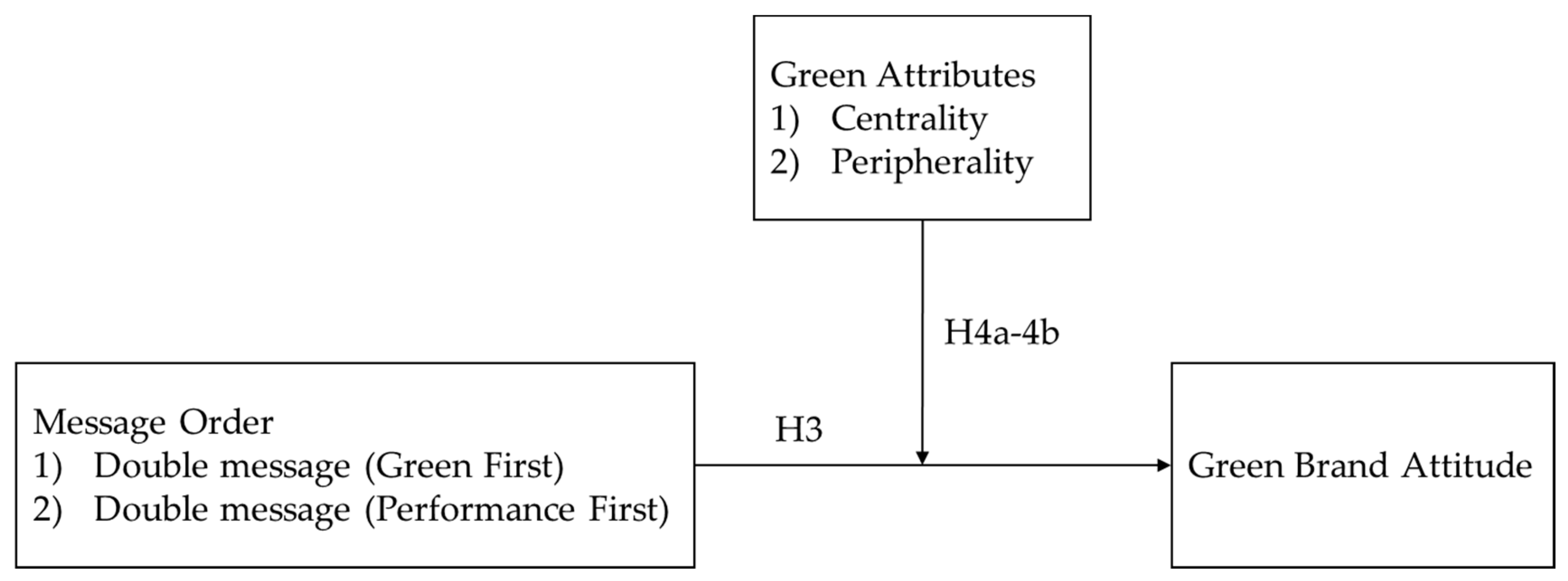
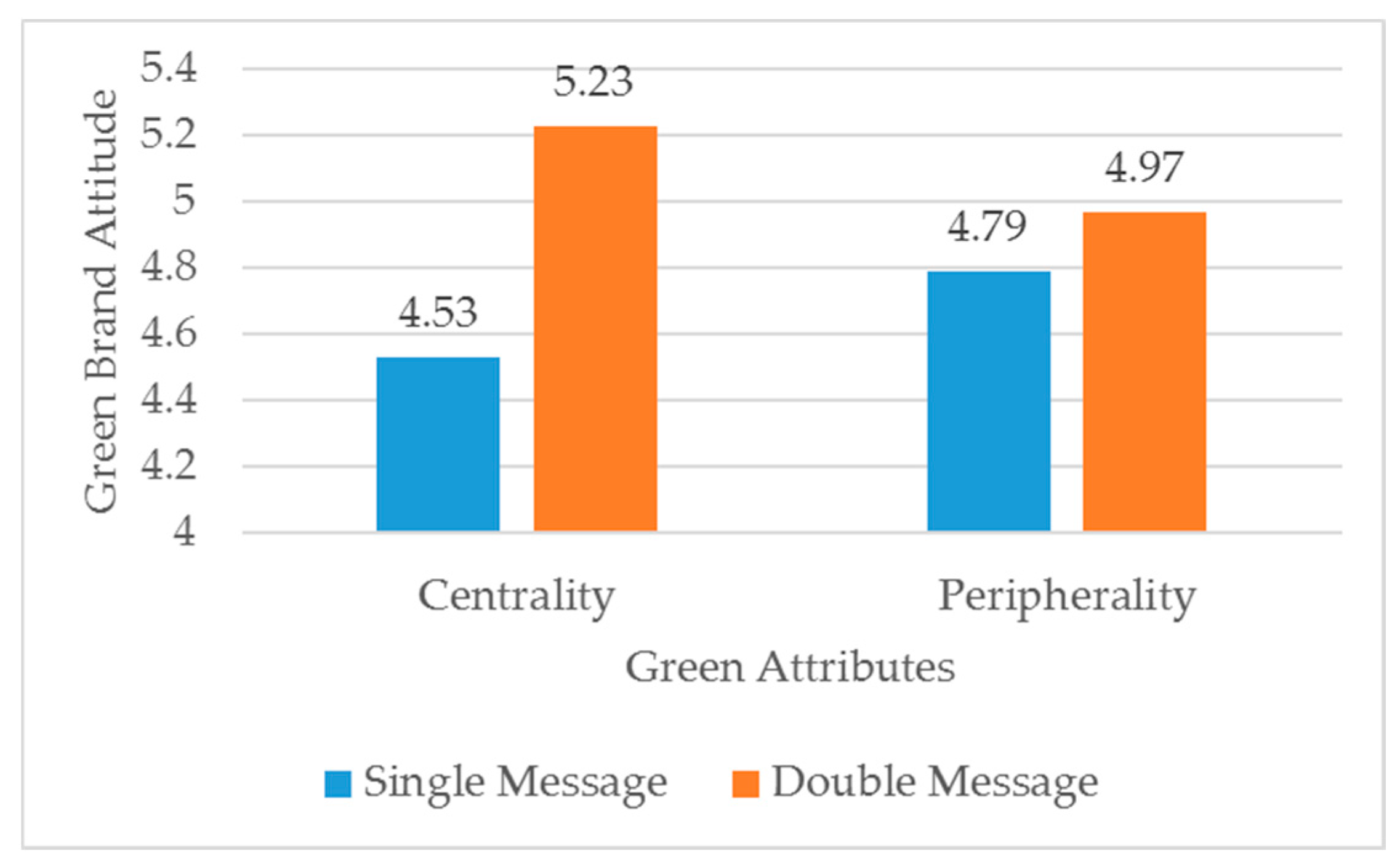
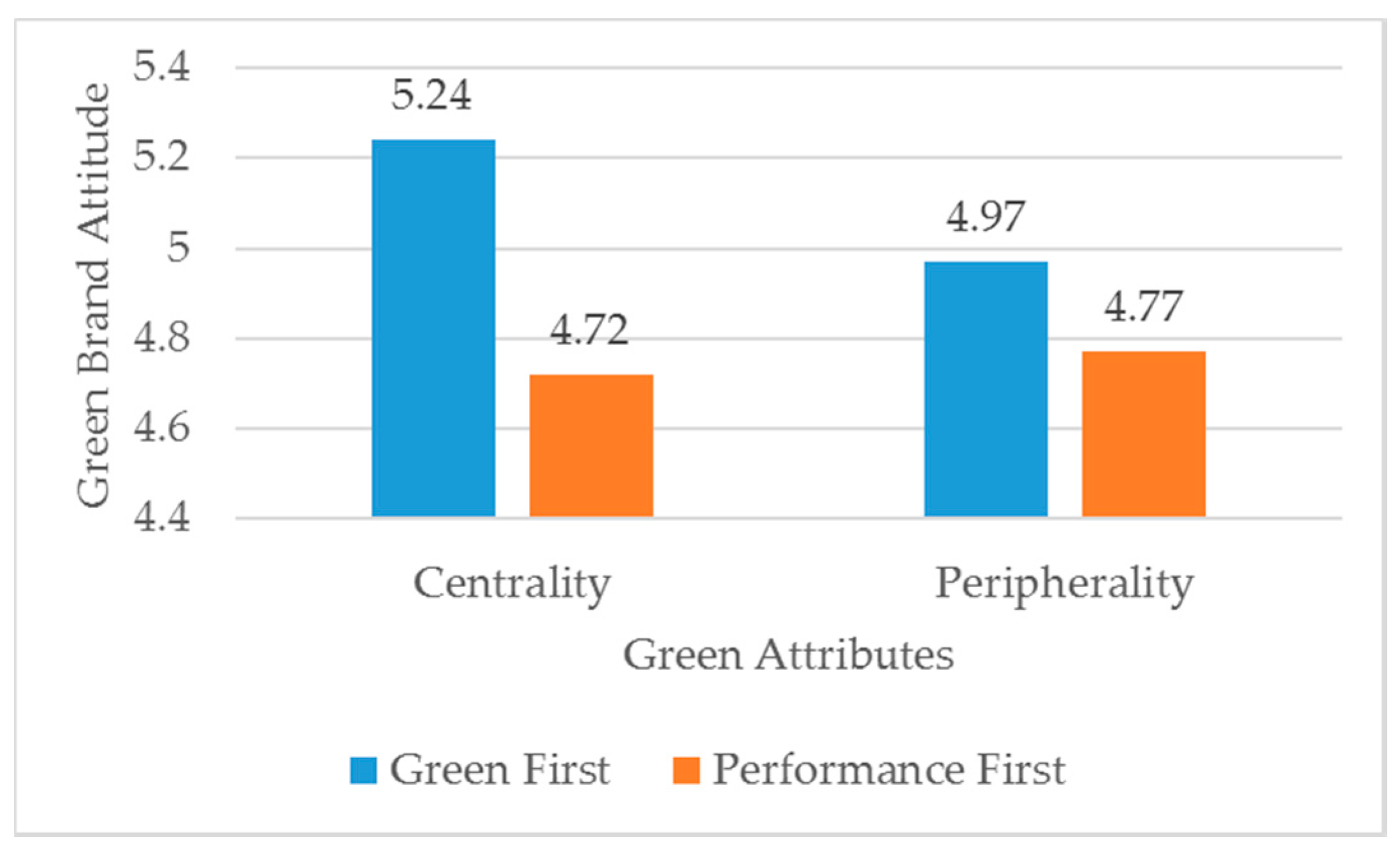
© 2020 by the authors. Licensee MDPI, Basel, Switzerland. This article is an open access article distributed under the terms and conditions of the Creative Commons Attribution (CC BY) license (http://creativecommons.org/licenses/by/4.0/).
Share and Cite
Chen, A.C.-H.; Wu, H.-H. How Should Green Messages Be Framed: Single or Double? Sustainability 2020, 12, 4257. https://doi.org/10.3390/su12104257
Chen AC-H, Wu H-H. How Should Green Messages Be Framed: Single or Double? Sustainability. 2020; 12(10):4257. https://doi.org/10.3390/su12104257
Chicago/Turabian StyleChen, Arthur Cheng-Hsui, and Hsiu-Hui Wu. 2020. "How Should Green Messages Be Framed: Single or Double?" Sustainability 12, no. 10: 4257. https://doi.org/10.3390/su12104257
APA StyleChen, A. C.-H., & Wu, H.-H. (2020). How Should Green Messages Be Framed: Single or Double? Sustainability, 12(10), 4257. https://doi.org/10.3390/su12104257




